Papaya production is of great commercial importance because of its high nutritional and medicinal value. Papaya (Carica Papaya) is a tropical fruit. Papaya is a very productive and interesting crop. It is easy to grow as a short-term crop. As raw fruit, it is used in cooking and some preparations. Let’s check out the Top 20 steps to boost papaya yield below.
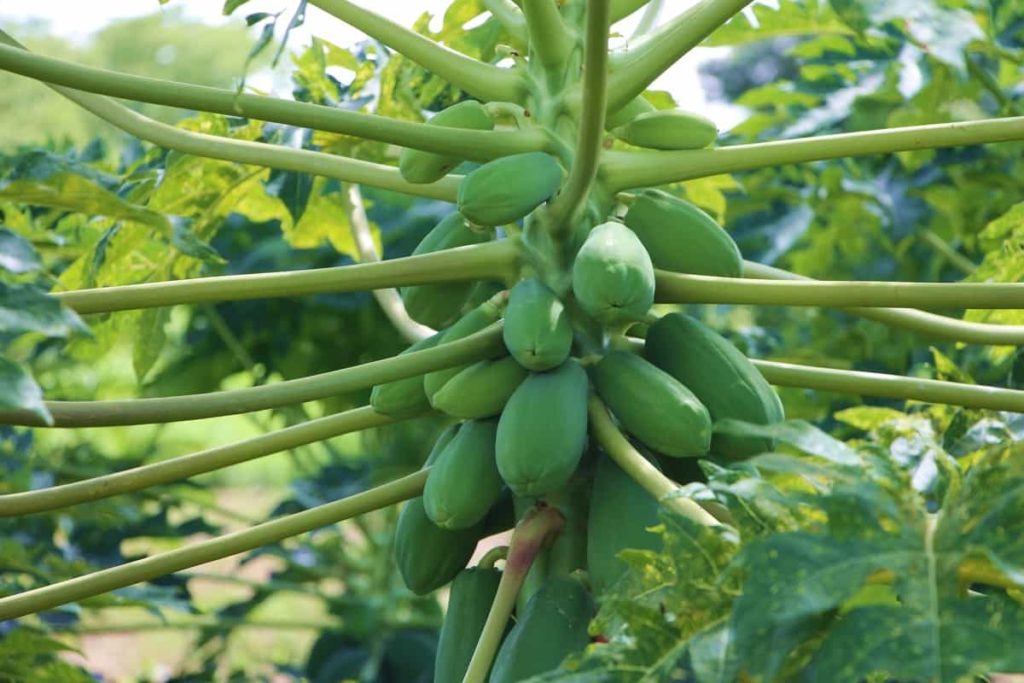
Top 20 steps to boost Papaya yield
Step 1: Soil management for high crop yield
High fertile soil with good drainage is most required for the successful cultivation of soil Papaya. The plant grows well in sandy loam soils with pH between 6.5 and 7. Papaya grows under a wide variety of soils. However, very shallow and very deep black soil is not suitable for Papaya cultivation. Fertile, well-drained, and lime-free soil is preferred for better fruit growth.
Step 2: Appropriate growing conditions will increase production
Papaya is planted during the spring (February-March), and the plant requires a large amount of fertilizer and manure. With these conditions, you need to increase your Papaya production by 40% and maintain its premium quality. The flowers of the Papaya crop thrive in humid climates in hot climates and in, dry climates in cold climates. Exposure to extremely low temperatures can damage leaves and even kill plants.
Step 3: Land preparation for more yield
A well-drained upland is selected for cultivation. In open and highlands, plants are exposed to strong winds or storms. Therefore, proper windbreak should be applied within the boundaries for planting Papaya.
Step 4: Proper spacing for enhancing the fruit yield
1.8 x 1.8-meter spacing is usually followed. However, high-density cultivation with an interval of 1.5 x 1.5 meters per hectare increases the profit to the farmer and is recommended. Pusha Nanha has been adopted for planting high-density plants with 6,400 plants per hectare.
In case you missed it: Best Fertilizers for Papaya Trees
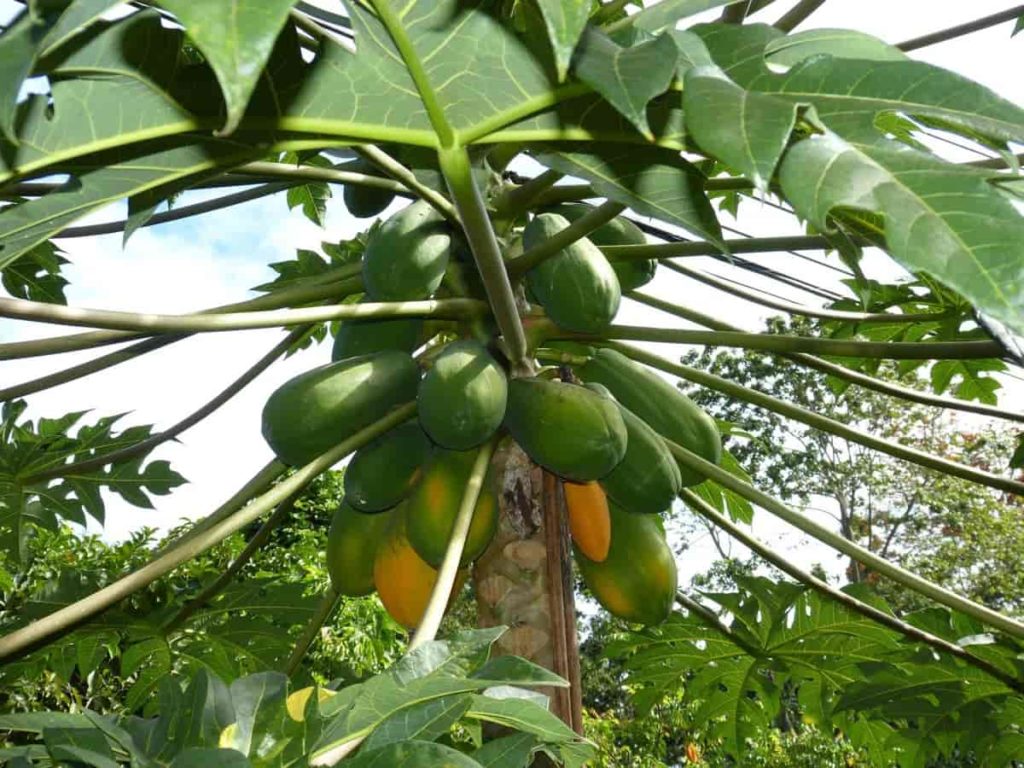
Step 5: Propagation
Generally, Papaya is grown from seed. Dried seeds can be stored in airtight refrigerated containers for one year or more. Fresh Papaya seeds germinate in 10 to 14 days. Transplanting is usually limited to areas with reliable rainfall or additional irrigation. When sowing directly, 10 to 15 seeds are sown at 1/4-to-1/2-inch (63 to 127 mm) depth in each plant hole. Approximately 0.5 cubic feet of soil should be added to each planting hole to ensure proper standing in lava lands. Soil helps to maintain fertilizer nutrients and moisture.
Step 6: Inter-cropping and inter-cultivation to increase Papaya production
Anyone can do intercropping in Papaya cultivation. Firstly, grow a variety of short-term vegetables for about six months after planting Papaya.
Sep 7: Seed rate
Seed and tissue culture plants commercially propagate it. Approximately 250-300 grams of Papaya seed is sufficient for one hectare of planting.
Step 8: Nutrition plays an essential role in plant growth
The Papaya plant needs large amounts of fertilizers and manures. The basic dose of fertilizer (@ 10 kg/plant) planted in pits, 200-250 grams each of N, P2O5, and K2O, is recommended for higher yields. Application of 200 grams N is best for fruit production, but papain production increases with an increase of N to 300 grams.
Newly planted Papayas need phosphorus for proper root formation. So, it is good to fertilize the Papaya tree before planting. Papaya trees are relatively less caring, but that doesn’t mean they don’t need suitable fertilizers to grow fast and grow well. A balanced C / N (Carbon: Nitrogen) ratio is necessary for proper fruiting. The following food fertilizers are recommended per plant to get maximum fruit yield.
Step 9: Micronutrients to increase fruit growth
Micronutrients such as ZnSO4 (0.5%) and H2 BO3 (0.1%) are sprayed to increase growth and yield.
Step 10: Compost for fruit growth
It is good to use compost to feed Papaya trees directly from essential nutrients, including nitrogen. Compost helps improve drainage and creates better soil conditions for Papaya trees. Add two parts of fertilizer to the bottom before planting your Papaya tree. It would help if you fertilized regularly to help the Papaya tree grow properly and the fruit grow. Always remember to water your Papaya tree immediately after fertilizing.
In case you missed it: High Density Papaya Plantation – Spacing, Yield In India
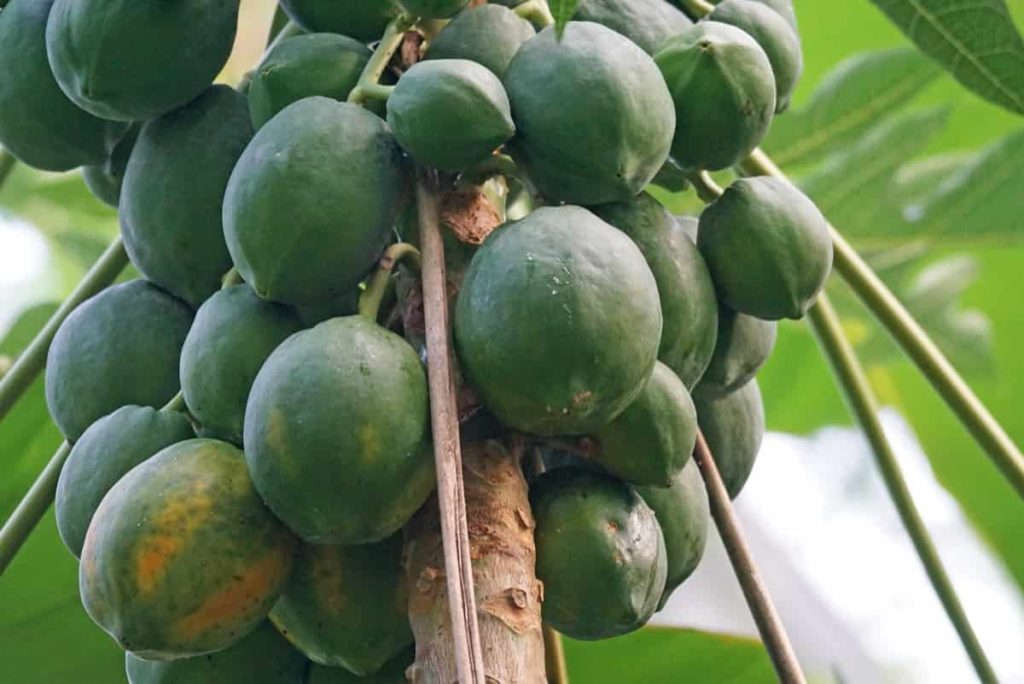
Step 11: Papaya variety selection for more yield
Important varieties are Honey Dew, Washington, Coorg Green, Honey Dew, Pusa Delicious, Ranchi selection, Taiwan varieties like a golden queen, No 815, and others.
- Pusa varieties – Pusa Delicious, Pusa Majesty, Pusa Jiant, Pusa Dwarf, Pusa Nanha
- Coimbatore varieties – Co2, Co3, Co5, Co4, Co5, Co6
Step 12: The correct way of watering will improve fruit growth
Papaya has large leaves. In hot climates, a lot of water evaporates through them. Therefore, it is essential to provide plenty of water to your plants, especially during the early stages of development. However, over-watering is also a significant problem leading to root rot. This problem often occurs in cold seasons when evaporation levels subside. In addition, Papayas are very sensitive to the accumulation of water caused by heavy rainfall in non-porous soils. It is better to choose a slightly sloping field than a perfectly level field in such cases.
Step 13: Proper irrigation for good yield
Make a proper watering plan based on the current climate and soil conditions to help your plants grow best. For optimal growth of young plants and good production of bearing plants, Papaya should be irrigated to meet the required rainfall. When rainfall is limited, commercial farmers can apply 10 gallons (37,851) of water per tree per day to bearing trees.
Step 14: Weed control practices for plant growth
Good weed control methods can also increase yields. Weeding in the Papaya crop is usually done by hoeing or tilling. Herbicides such as Diuron @ 2.0-2.5 kilograms of active ingredient per hectare or Glyphosate @ 1-2 kilograms of active ingredient per hectare help control weeds in Papaya orchards. Care should be taken when spraying to prevent the spread of weeds on Papaya leaves.
Step 15: Fruit thinning for increased fruit size
Healthy Papaya trees can be expected to flower for about 4-6 months from the time of transplanting. Fruit thinning is necessary to regulate production and improve uniform size marketable fruit percentages. After the fruit set, the early stages of fruit development are much faster. Therefore, any fruit that remains undeveloped for a week or so in a row is unlikely to be marketable. Poor growth is usually due to poor pollination and fertilization.
In case you missed it: Organic Papaya Farming – Cultivation, Production In India
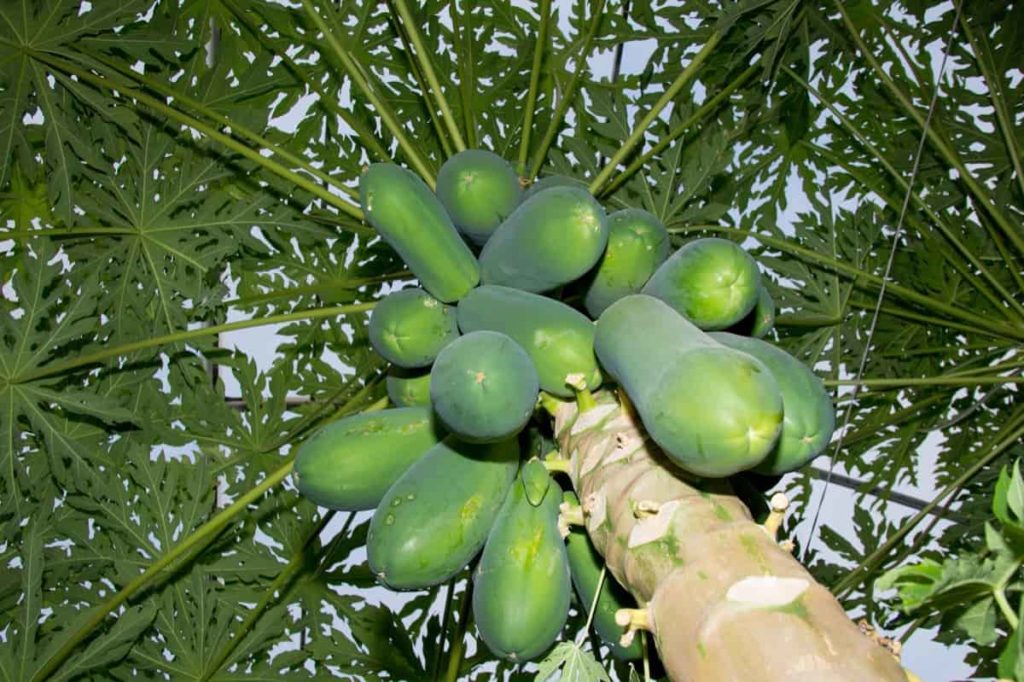
Such fruits are generally smaller and much smaller than the seed and should be picked up by hand early. In some cases, especially in very wet and cold conditions, Papaya produces carpelloid fruit. This defect also appears at the flowering stage, and such fruits can be identified and eliminated quickly. Thrips, mites, and diseases damage other fruits that should be discarded.
The best varieties of Papaya set the single fruit. It is also recommended to maintain a single fruit per node. Only the largest should be retained when some nodes have two or more fruits. The thinning of the fruit will result in a higher percentage of well-formed, uniformly sized fruits as all the parasitic malformed fruits which are not of economic importance have been removed at the very beginning of their development.
Step 16: Possible causes of Papaya flower drop and preventive measures
- Temperature and relative humidity [RH], especially near and around the micro-climate of flowers between 20 to 33°C and 70% to 85%, respectively. Lesser and higher than this range affects the flower drop in Papaya.
- Low and high levels of nitrogen can cause the flowers to fall off.
- Dehydration and excess moisture can affect flower growth, pollination, fertilization, and fruit set. An unequal water supply to Papaya plants/trees causes stress, resulting in uneven flowering and fruiting.
- Reduced or extended light has a negative effect on flower growth, pollination, fertilization, and fruit set.
Things that can be controlled are disease, and pest management can be monitored to prevent flower drop and maximize yields. Properly balanced nutrition can also help achieve good flower health and good fruit arrangement in the Papaya crop.
In case you missed it: Papaya Pests and Diseases, Control Management
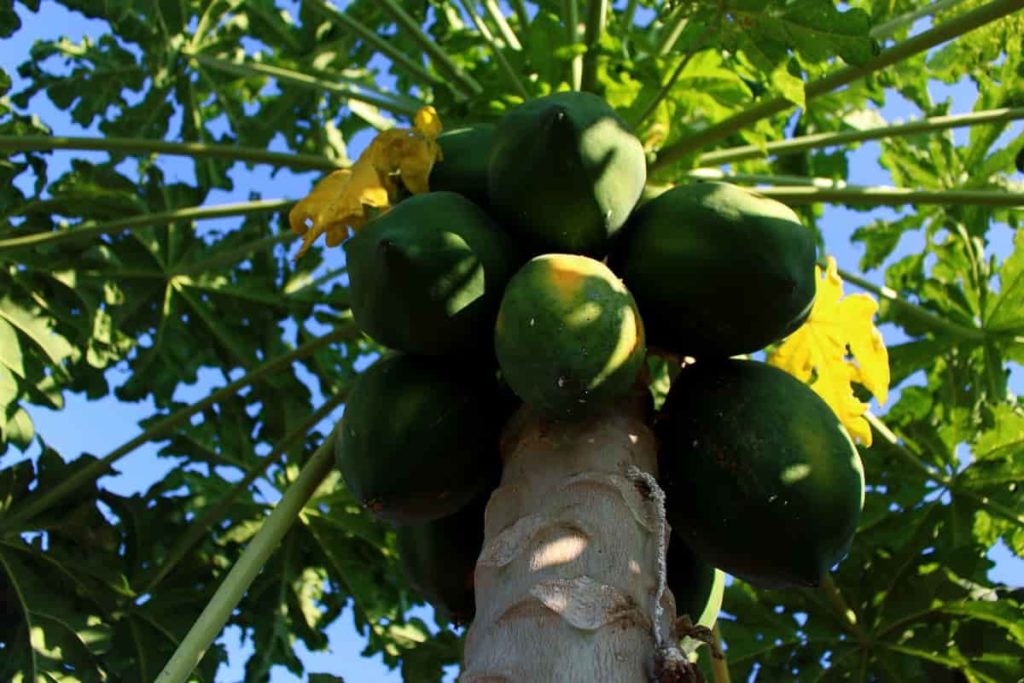
Step 17: Causes of Papaya fruit drop and prevention methods
Natural fruit drop in Papaya – If the Papaya fruit is falling when it is small, about the size of golf balls, the fall of the fruit is probably natural. A female Papaya plant naturally bears fruit from flowers that were not pollen. It is natural because an unpollinated flower fails to become a fruit.
- Water problems – Papaya trees love water, but not much.
- Pests – If the Papaya fruit fly larvae attack your Papaya fruit, they are more likely to turn yellow and then fall to the ground. For avoiding this problem, tie a paper bag around each Papaya fruit.
Step 18: Papaya fruits are so small and how to overcome this problem:
- Irregular watering – When compared to other plants, the water requirement of Papaya plants is initially limited. Therefore, if your plant does not have proper irrigation, its fruits may be small. It would help if you watered your Papaya plants properly in the bearing stage. At this stage, Papaya plants need 25 to 35 liters of water per day. But it can vary depending on your area’s climate and weather conditions. For example, if you are in a place where it rains regularly, you need to water the Papaya plants in the rain.
- Lack of space – If your Papaya plant does not have enough space, it must compete with other plants for water and nutrients. Because of this, these plants cannot provide you with the right size fruit. Therefore, you should ensure enough space in your Papaya plant, especially if you are a farmer.
- Lack of nutrients or fertilizers – Nutrients are the key to a healthy plant. Therefore, if your Papaya plant does not meet its nutritional needs, it will not produce good fruit. If you want to maintain a constant supply of Papaya fruit, it is essential to provide adequate fertilizer from time to time. On the other hand, a balanced Papaya fruit must have a balanced carbon: nitrogen (C / N) ratio. Also, nitrogen, phosphorus, and potassium play essential roles in Papaya crop production. Therefore, it is necessary to maintain its balance to get a good crop.
In case you missed it: Papaya Flower and Fruit Drop, Causes, Control Methods
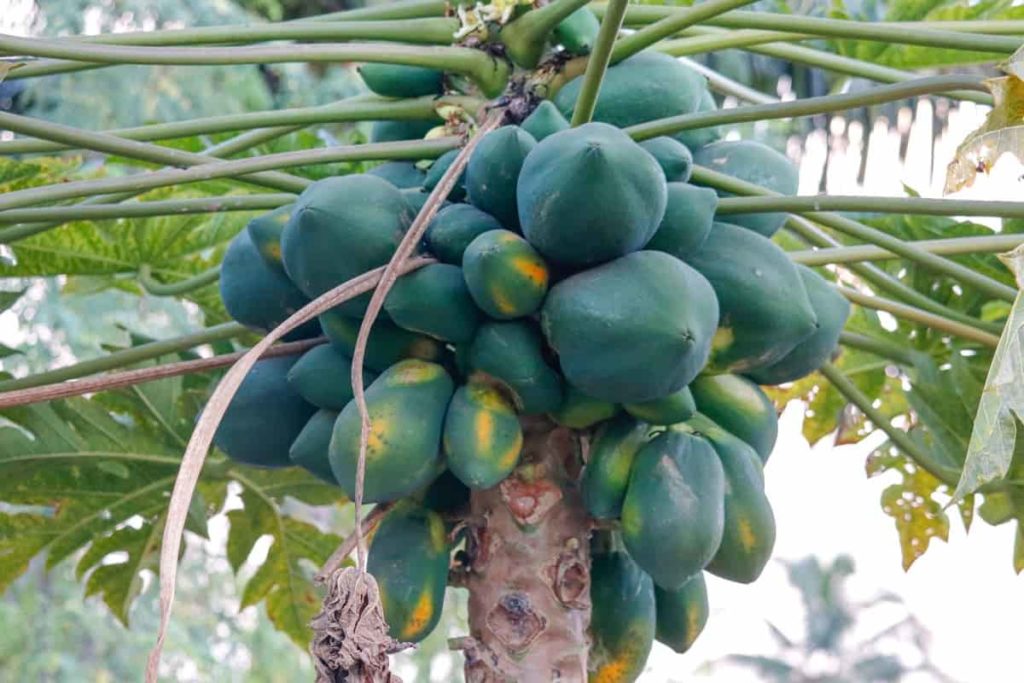
Step 19: Pests and diseases control will increase the crop yield
Root rots can cause rapid death of Papaya plants. The only solution is to plant new plants in a better place with better drainage. Watering should be done carefully. Viral diseases are quite common and uncontrollable. They usually clear the veins and cause yellowing of the leaves. Other symptoms include distorted leaf development with stagnation, poor set, and the presence of various greasy or yellow circles on the leaves and fruits. Infected plants should be removed and destroyed. Anthracnose appears as irregular, water-soaked spots on fruits that later become large, black, and sink into the bark.
Copper sprays have had a limited effect in severe cases, but they would not be expected to be widely used under normal circumstances. The common Whitefly is just about an insect-infected Papaya, forming a sooty mold on fruits. Sweetpotato Whitefly is also reported to like Papaya. The safest control is to spray with a solution of soapy water. Insects that attack aphids, red spider mites, stem borers, fruit flies, gray weevils, and grasshoppers are Papaya plants. Destroying the infected part and prophylactic sprays such as 0.3% dimethoate will help control the affected area.
Step 20: Harvesting time
Papaya fruit harvesting should be done after the color break – when some yellow color is shown on the fruit – but before it is entirely yellow (approximately 9 to 14 months after planting). If left on the Papaya tree to ripen, the fruit is often damaged by fruit flies and birds.
- How to Make Houseplants Bushy: Effective Tips and Ideas
- Innovative Strategies for Boosting Coconut Pollination and Yield
- Pollination Strategies for Maximum Pumpkin Yield
- The Complete Guide to Chicken Fattening: Strategies for Maximum Growth
- Natural Solutions for Tulip Problems: 100% Effective Remedies for Leaf and Bulb-Related Issues
- Revolutionizing Citrus Preservation: Towards a Healthier, Greener Future
- Natural Solutions for Peony Leaf and Flower Problems: 100% Effective Remedies
- Maximizing Profits with Avocado Contract Farming in India: A Comprehensive Guide
- Natural Solutions for Hydrangea Problems: 100% Effective Remedies for Leaf and Flowers
- The Ultimate Guide to Choosing the Perfect Foliage Friend: Bringing Life Indoors
- From Sunlight to Sustainability: 15 Ways to Use Solar Technology in Agriculture
- The Ultimate Guide to Dong Tao Chicken: Exploring from History to Raising
- The Eco-Friendly Makeover: How to Convert Your Unused Swimming Pool into a Fish Pond
- Mastering the Art of Delaware Chicken Farming: Essentials for Healthy Backyard Flocks
- 20 Best Homemade Fertilizers for Money Plant: DIY Recipes and Application Methods
- How to Craft a Comprehensive Free-Range Chicken Farming Business Plan
- Brighten Your Flock: Raising Easter Egger Chickens for Beauty and Bounty
- How to Optimize Your Poultry Egg Farm Business Plan with These Strategies
- Subsidy for Spirulina Cultivation: How Indian Government Schemes Encouraging Spirulina Farmers
- Ultimate Guide to Raising Dominique Chickens: Breeding, Feeding, Egg-Production, and Care
- Mastering the Art of Raising Jersey Giant Chickens: Care, Feeding, and More
- Ultimate Guide to Raising Legbar Chickens: Breeding, Farming Practices, Diet, Egg-Production
- How to Raise Welsummer Chickens: A Comprehensive Guide for Beginners
- How to Protect Indoor Plants in Winter: A Comprehensive Guide
- Ultimate Guide to Grow Bag Gardening: Tips, Tricks, and Planting Ideas for Urban Gardeners
- Guide to Lotus Cultivation: How to Propagate, Plant, Grow, Care, Cost, and Profit
- Agriculture Drone Subsidy Scheme: Government Kisan Subsidy, License, and How to Apply Online
- Ultimate Guide to Raising Araucana Chickens: Breed Profile, Farming Economics, Diet, and Care
- Bringing Hydroponics to Classroom: Importance, Benefits of Learning for School Students
- Ultimate Guide to Raising Polish Chickens: Breed Profile, Farming Economics, Diet, and Care
- Ultimate Guide to Raising Australorp Chickens: Profile, Farming Economics, Egg Production, Diet, and Care
- Silkie Chicken Farming: Raising Practices, Varieties, Egg Production, Diet, and Care
- Sussex Chicken Farming: Raising Practices, Varieties, Egg Production, Diet and Care
- Homemade Feed Formulations for Livestock: Discover Cost-effective Starter to Finisher Feed Recipes
- 20 Best Pig Weight Gain Supplements: Top Swine Weight Gain Formulas
- Ultimate Guide to Elderberry Farming: Propagation, Planting, Yield, Cost, and Profit